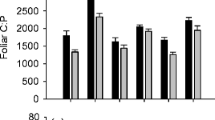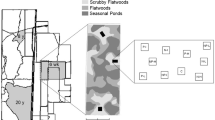Summary
The relationship between fire frequency and N limitation to foliage production in tallgrass prairie was studied with a series of fire and N addition experiments. Results indicated that fire history affected the magnitude of the vegetation response to fire and to N additions. Sites not burned for over 15 years averaged only a 9% increase in foliage biomass in response to N enrichment. In contrast, foliage production increased an average of 68% in response to N additions on annually burned sites, while infrequently burned sites, burned in the year of the study, averaged a 45% increase. These findings are consistent with reports indicating that reduced plant growth on unburned prairie is due to shading and lower soil temperatures, while foliage production on frequently burned areas is constrained by N availability. Infrequent burning of unfertilized prairie therefore results in a maximum production response in the year of burning relative to either annually burned or long-term unburned sites.
Foliage biomass of tallgrass prairie is dominated by C4 grasses; however, forb species exhibited stronger production responses to nitrogen additions than did the grasses. After four years of annual N additions, forb biomass exceeded that of grass biomass on unburned plots, and grasses exhibited a negative response to fertilizer, probably due to competition from the forbs. The dominant C4 grasses may out-compete forbs under frequent fire conditions not only because they are better adapted to direct effects of burning, but because they can grow better under low available N regimes created by frequent fire.
Similar content being viewed by others
References
Aber JD, Nadelhoffer KJ, Steudler P, Melillo JM (1989) Nitrogen saturation in northern forest ecosystems. BioScience 39:378–386
Abrams MD, Knapp AK, Hulbert LC (1986) A ten-year record of aboveground biomass in a Kansas tallgrass prairie: effects of fire and topographic position. Am J Bot 73: 1509–1515
Briggs JM, Knapp AK (1991) Estimating aboveground biomass in tallgrass prairie with the harvest method: Determining proper sample size using jackknifing and monte carlo simulations. South Nat 36: 1–6
Briggs JM, Seastedt TR, Gibson DJ (1989) Comparative analysis of temporal and spatial variability in above-ground production in a deciduous forest and prairie. Holar Ecol 12: 130–136
Chapin FS, Vitousek PM, Van Cleve K (1986) The nature of nutrient limitation in plant communities. Am Natural 127: 48–58
Eisele K, Schimel DS, Kapustka LA, Parton WJ (1989) Effects of available P and N:P ratios on non-symbiotic nitrogen fixation in prairie soils. Oecologia 79: 471–474
Gibson DJ (1988) Regeneration and fluctuation of tallgrass prairie vegetation in response to burning frequency. Bull Tor Botan Club 115: 1–12
Gibson DJ, Hulbert LC (1987) Effects of fire, topography and year-to-year climatic variation on species composition in tallgrass prairie. Vegetatio 72: 175–185
Hayes DC, Seastedt TR (1989) Nitrogen dynamics of soil water in burned and unburned tallgrass prairie. Soil Biol Biochem 21: 1003–1007
Huenneke LF, Hamburg SP, Koide R, Mooney HA, Vitousek PM (1990) Effects of soil resources on plant invasion and community structure in a Californian serpentine grassland. Ecology 71: 478–491
Hulbert LC (1988) Causes of fire effects in tallgrass prairie. Ecology 69: 46–58
Hulbert LC, Wilson JK (1983) Fire interval effects on flowering of grasses in Kansas Bluestem Prairie. In: Kucera CL (ed), Proceedings of the Seventh North American Prairie Conference. Southwest Missouri State University, Springfield, pp 255–257
Hurlbert LC (1984) Pseudoreplication and the design of ecological field experiments. Ecol Monogr 54: 187–211
Huston M (1979) A general hypothesis of species diversity. Am Nat 113: 81–101
Knapp AK (1985) Effect of fire and drought on the ecophysiology of Andropogon gerardii and Panicum virgatum in a tallgrass prairie. Ecology 66: 1309–1320
Knapp AK, Seastedt TR (1986) Detritus accumulation limits the productivity of tallgrass prairie. BioScience 36: 662–668
Ojima DS (1987) The short-term and long-term effects of burning on tallgrass ecosystem properties and dynamics. Ph.D. Dissertation, Colo. State Univ., Ft. Collins, CO., p 98
Ojima DS, Parton WJ, Schimel DS, Owensby CE (1990) Simulated impact of annual burning on prairie ecosystems In: Collins SL, Wallace LL (eds). Fire in North American Tallgrass Prairie. University of Oklahoma Press, Norman, Oklahoma, pp 118–132
Old SM (1969) Microclimates, fire and plant production in an Illinois prairie. Ecol Monogr 39: 355–384
Owensby CE, Smith EF (1979) Fertilizing and burning Flint Hills bluestem. J Rang Manag 32: 254–258
Owensby CE, Hyde RM, Anderson KL (1970) Effects of clipping and supplemental nitrogen and water on loamy upland bluestem prairie. J Rang Manag 23: 341–346
Parton WJ, Schimel DS, Cole CV, Ojima D (1987) Analysis of factors controlling soil organic levels of grasslands in the Great Plains. Soil Sci Soc Am J 51: 1173–1179
Reimers WA (1983) Disturbance and basic properties of ecosystem energetics. In: Mooney H, Godron M (eds). Disturbance and Ecosystems: Components of Response. Springer, Berlin, pp 83–98
Seastedt TR (1988) Mass, nitrogen and phosphorus dynamics of foliage and root detritus of tallgrass prairie. Ecology 69: 59–65
Seastedt TR, Hayes DC (1988) Factors influencing nitrogen concentrations in soil water in a North American tallgrass prairie. Soil Biol Biochem 20: 725–729
Seastedt TR, Ramundo RA (1990) The influence of fire on below-ground processes of tallgrass prairic. In: Collins SL, Wallace LL (eds). Fire in North American Tallgrass Prairies. University Oklahoma Press, Norman, Oklahoma, pp 99–117
Towne G, Owensby CE (1984) Long-term effects of annual burning at different dates in ungrazed Kansas tallgrass prairie. J Rang Manag 37: 392–397
Trudgill ST (1977) Soil and Vegetation Systems Oxford University Press, Oxford, p 177
Wedin DA, Tilman D (1991) Species effects on nitrogen cycling: A test with perennial grasses. Oecologia (in press)
Author information
Authors and Affiliations
Rights and permissions
About this article
Cite this article
Seastedt, T.R., Briggs, J.M. & Gibson, D.J. Controls of nitrogen limitation in tallgrass prairie. Oecologia 87, 72–79 (1991). https://doi.org/10.1007/BF00323782
Received:
Accepted:
Issue Date:
DOI: https://doi.org/10.1007/BF00323782




